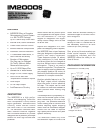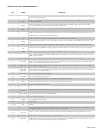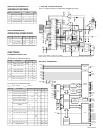
REV101805
IM2000S PIN ASSIGNMENTS
PIN
NAME
FUNCTION
59
SCLK
Step clock input. A positive going edge on this input will advance the motor one increment (the size of the increment is dependent
on the microstep select inputs).
52
RSEL
ROM select input. When low, this input selects the internal sine/cosine ROM. When high, AD0-AD8 are selected for use with
an external lookup table.
57
RESET
Reset input. When low, this input will reset the IM2000S (PWM, Enable and Full Bridge outputs will be disabled). When
released, the controller will be at its initial state (sine at 0, cosine at peak).
60
DIR
Direction input. This input is used to change the direction of the motor. Physical direction also depends on the connection of the
motor windings.
53
CSEL
Clock select input. When low, the SCLK input will be directed to the internal sine/cosine generator independent of the level of
the EN input. When high, the SCLK input will be directed to the COUT output when the EN input is low and, conversely, to the
internal sine/cosine generator when the EN input is high.
61
EN
Enable input. When low, this input will enable/disable the PWM and full bridge output signals.
62
FSTEP
On fullstep output signal. This active low output indicates when sine & cosine outputs of the IM2000S are positioned on a full
step.
63
FAULT
Fault output signal. This active high output indicates when a fault has occurred. It will stay active until the IM2000S is reset.
64
WR
Write input. When the IM2000S is con gured in the buss mode, this input is used to latch in the microstep select, enable and
direction inputs.
1
MODE
Mode select input. This input is used to con gure the IM2000S in a stand-alone or buss mode.
45, 2
PWMA, PWMB
Phase A and Phase B pulse width modulated output signals. These outputs can be used to control the phase currents in common
PWM type power sections.
44, 3
SIGNA, SIGNB
Sign of A and sign of B output signals. These outputs indicate the sign of the sine and the sign of the cosine.
43, 4
ENA, ENB
Phase A and Phase B enable output signals. These active high outputs, which work in conjunction with the enable input of PIN 6,
can be used to enable/disable the power section of the driver.
38, 39, 41, 42
HRA, LRA,
LLA, HLA
Phase A high side and low side full bridge control signals. These outputs can be used to control discrete P-N or N-N full bridge
sections or half and full bridge ICs.
5, 6, 8, 9
HLB, LLB,
LRB, HRB
Phase B high side and low side full bridge control signals. These outputs can be used to control discrete P-N or N-N full bridge
power sections or half and full bridge ICs.
12–19
COS0–COS7
Cosine waveform output signals for Phase B.
28–35
SIN7–SIN0
Sine waveform output signals for Phase A.
47
IHI
Polarity select input for active high or active low high side full bridge control outputs.
46
ILOW
Polarity select input for active high or active low low side full bridge control outputs.
36, 11
VSA, VSB
Phase A and Phase B current sense inputs.
37, 10
OVCA, OVCB
Phase A and Phase B over current/short circuit protection inputs.
20
CURRED
Automatic current reduction output signal. This active high output is used to automatically reduce the driver output current 1
second after the last step clock input.
22, 23
OSCRC, OSCR
Resistor/capacitor inputs for on-board PWM oscillator.
24
OVV
Over voltage protection input.
26
OVTMP
Over temperature protection input.
25, 58
VCC
Supply voltage.
7, 21, 40, 54
GND
Ground.
48–51
MSEL0–MSEL3
Microstep resolution select inputs. These inputs are used to select the number of microsteps per full step. The available resolu-
tions (microsteps/step) are: 2, 4, 5, 8, 10, 16, 25, 32, 50, 64, 125, 128, 250, 256.
12–19
AD0–AD7
Address 0 - Address 7. These outputs are used in conjunction with external lookup tables for user supplied sine and cosine
curves.
27
COUT
SCLK output. This output is dependent on the CSEL and EN inputs.
55, 56
CIR0, CIR1
PWM circulation select inputs. These inputs are used to select whether or not the PWM will be in a recirculating or a non-recir-
culating mode, or an automatic recirculating and non-recirculating mode.





